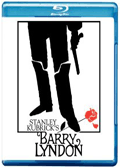Stanley Kubrick: Part II
 In Part I, the focus was on Lolita [M] (1962) and Stanley Kubrick’s early documentaries, but this time we jump ahead more than a decade to Barry Lyndon [M] (1975), and a teasing little Channel 4 documentary called Stanley Kubrick’s Boxes [M] (2008).
In Part I, the focus was on Lolita [M] (1962) and Stanley Kubrick’s early documentaries, but this time we jump ahead more than a decade to Barry Lyndon [M] (1975), and a teasing little Channel 4 documentary called Stanley Kubrick’s Boxes [M] (2008).
Lolita forms the beginning of Kubrick’s comfort in letting loose his satirical streak. In that film, the target was socially wrong behaviour with an emphasis on the innate clumsiness and petty jealousies of a shallow professor whose maturity is so low, he doesn’t deserve the degree that permits him to walk into any classroom. In fact, he shouldn’t be allowed to enter any classroom, even by accident.
Dr. Strangelove (1964) was a sharp, incessant stream of missives at the insanity of war-mongering in the atomic age. Unlike Peter Watkins, who in The War Game (1965) used the docu-drama format to show how foolish the concept of surviving a direct nuclear strike was, Kubrick filled the screen with manic archetypes whose collective behaviour result in a global kaboom, set to Vera Lynn crooning the schmaltzy WWII classique “Well Meet Again.”
A Clockwork Orange (1971) satirized violence, and Barry Lyndon slowly dramatized Thackeray’s own poke at the rake (a no good swine who manages to avoid paying for his amoral behaviour until he mismanages control of his ill-gotten paradise, and loses face in chunks).
Like Lolita, Barry Lyndon makes its cleaned up debut on Blu-ray via Warner Home Video, and I’ve uploaded a review that addresses the film, the transfer, and some links regarding the somewhat overheated debate over its correct aspect ratio. (For the record: while WHV’s BR sleeve states 1.85:1, the film is presented at 1.78:1.)
Moving on, British documentarian Jon Ronson decided it was only logical make a film during the 5 years he was given access to the mass of boxes Kubrick had stored in virtually every room in the family’s estate.
A masterful self-serving archivist, Kubrick had thousands of boxes containing ephemera, production documents, stills, film, and correspondences which he kept out of mania, perfectionism, and a certain series of logical assumptions: methodical documentation could prove helpful in retracing some aspect of a film’s history from pre-production to home video release.
In the case of unrealized productions (such as attempts to get separate films of Napoleon Bonaparte and the Holocaust off the ground), if luck ever turned, he could theoretically pick up where he had left off a decade earlier without losing too many days of re-familiarizing himself (and new personnel) with minute details.
Kubrick wasn’t crazy or a thorough recluse, but he did prefer his privacy, and being a brilliant man, an overactive brain could hyper-focus on designing the perfect stationary just as much as pulling off the most realistic depiction of the moon’s surface before elaborate probe photography and manned lunar landings gave us actual photographic details.
As Ronson explains in an intro to the doc, he wanted the boxes to tell us aspects of Kubrick without judgment; in the film, the reactions of others are subjective, but what’s found are artifacts, and it’s up to each one of us to reconsider our impression of this icon, or feel comfortable that we were right all along (crazy, genius, or a blend of both).
Sadly, Ronson’s doc has yet to appear on DVD, but it’s ripe material for inclusion on a future Blu-ray special edition of one of his films, if not its own release, with follow up material showing further details of the massive archives, what’s been learned by film historians, and how students and filmmakers have benefitted from the new information that lay dormant inside cardboard, and packing tape.
Between April and September of 2010, an exhibit culled from the Kubrick archives was housed at the Museum of St. Albans, and one hopes a revised version will tour across the pond to Canada and the U.S. in the near future. (The TIFF Bell Lightbox has already shown a Tim Burton exhibit, and their new Fellini (Fellini and Dreams) show is well underway, so who knows – perhaps we’ll get lucky.)
St. Albans is currently showing The Kiss Kiss Kill: The Graphic Art and Forgotten Spy Films of Old War Europe, an exhibit for gorgeous commercial art that is available for international tours.
If anyone at the TBL is reading, take a peek at the official site & archive, and think about the tie-in programming options, particularly those rarely seen Cold War dramas that would look gorgeous on the big screen (The Spy Who Came in from the Cold) and the myriad German, Italian, and East Block productions that have never been screened on this continent.
I’m just putting the idea out there.
.
.
Mark R. Hasan, Editor
KQEK.com
Category: EDITOR'S BLOG





Connect
Connect with us on the following social media platforms.